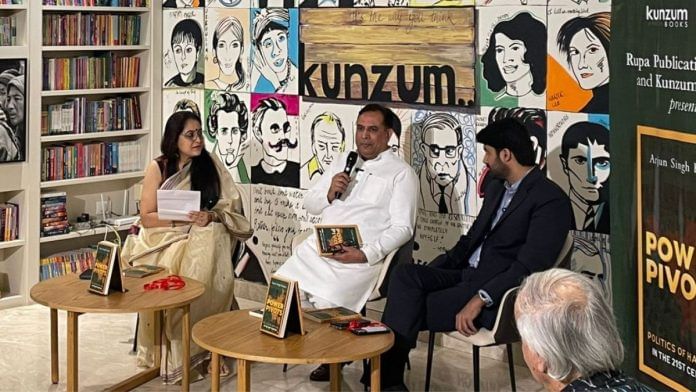New Delhi: Haryana may be a small state, but it wields considerable political muscle. And it was the state’s political evolution over the 21st century that took centre stage at the launch of Arjun Singh Kadian’s Power Pivots: Politics of Haryana in the 21st Century.
“Haryana is not what we read about from the lens of Delhi. It has changed a lot,” said Captain Abhimanyu Singh Sindhu, a former cabinet minister in the Haryana government who joined Kadian for a panel discussion. “There has been huge migration from the rural to urban areas. It is a largely urbanised state, strong as far as economic development is concerned.”
Held at Kunzum Books in Delhi’s Jor Bagh, the discussion panel was moderated by Lipika Bhushan, a publishing consultant. Close to 50 people, some clutching copies of the book, packed into the small space as Kadian explained why he decided to write his fourth book about politics, a thematic departure from his previous works.
“When I write about history and culture, I am trying to understand where we come from,” said Kadian, explaining why he wrote his debut book Land of the Gods: The Story of Haryana. “But where we are heading is perhaps shaped by politics of today.”
The politics
As both a close friend of Kadian’s family and an ‘insider’ of the Haryana political landscape, Sindhu was best placed to engage in a discussion on politics while also supporting the launch of the book. Bhushan turned to Sindhu and asked whether the common person in the state is politically active.
“Especially for a society which is considered to be deeply patriarchal,” said Bhushan. “Do you see youngsters, especially women, coming to the forefront and taking on initiatives and responsibilities and being vocal about what’s happening in the state?”
After a brief pause, Sindhu launched into a litany of reasons why Haryana has departed from its rural roots, an image that many outside the state still have. But it was when he discussed the political upheaval in the region that audience members — some from Haryana — nodded their heads in approval.
“It is not the patriarchal society of Haryana which is an issue but dynasty politics — which still pervades all parties,” he said, adding that this is a big resistance that the new generation must overcome. “As for women participation, in Haryana, they are active at all levels.”
Sindhu went on to explain that particularly in rural areas, women participation has increased. He pointed to Kadian’s book, which states that in 2014 the state had 13 women in the Haryana legislative Assembly. “It was one good development, but I hope that with reservation coming into effect, we will see a better change in the overall political environment,” he added.
Also read: Did the Emergency give freedom to Dalits? Book offers new perspective 50 years on
‘A panchayati mindset’
Kadian opens his book with Haryana native Neeraj Chopra’s meteoric rise as a javelin thrower and makes parallels to how people in the state now perceive themselves. Witnessing someone they can identify with had a profound impact on their self-image. But Bhushan asked Kadian whether he had seen this change on the ground, especially in rural Haryana.
“I believe Haryana operates with a panchayati mindset. We really look up to our elders and seniors,” said Kadian. “Say some senior or leader has been exposed to Delhi and seen opportunity in a field. That message gets passed on to the entire community.”
The message spreads like wildfire, passing between different communities and reaches smaller corners of the state, according to Kadian. “Data democratisation has helped. The exposure has increased multiple times and as a consequence there are success stories being written in small villages across the state,” he said.
He also went on to highlight that in the past 10-15 years, Gurgaon has also been a success story. Many local people have been exposed to opportunities in the city that other areas of Haryana could not offer them. And that has a trickle-down effect.
“Once Neeraj Chopra did it, stadiums across the state filled up with youngsters,” said Kadian, adding that witnessing an Indian scaling to such heights in a sport like javelin throw was almost unthinkable earlier. “In Haryana, we have always been little fitness conscious — this has found a new opportunity, an avenue we can excel at. And sports is just one arena.”
(Edited by Aamaan Alam Khan)






